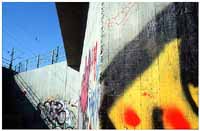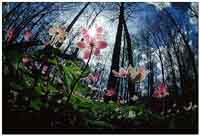
Bringing The Colours Back With Kodak's New Ektachromes
Review by Bjørn Rørslett
Old Yellow has seen hard times in its competition with the highly successful Japanese film giants. Nature photographers in particular have taken to Fuji Velvia the way ducks take to water. When more speed is called for, green film cartridges containing Sensia, Provia and Astia have been the choice of many. myself inclusive.
Fuji has aggressively priced their films on the European market to make Kodak's marketing position even more difficult. Had Kodak film been superior to the green ones, an elevated price would be easier to swallow for their customers. However, recent Kodak products such as the Panther/Lumiere range have been positively bad as far as colour rendition was concerned and sharpness was even worse. I myself wouldn't touch Kodachrome with a ten foot pole due to its lousy colours, lack of acuity, frequent development damages, high price and long processing delays, after such great films as Fuji Velvia emerged to commence the trend of today's vividly saturated colour films.
Now, although Velvia is the preferred choice of many, it's clear that this is not the film for all occasions. To wit, shooting Velvia in bright sunshine is simply asking for trouble due to Velvia's high contrast. True, downrating its speed to shoot at EI 40 throws a little more light into the shadows, but highlight areas concurrently can burn out and colour balance suffers.
The perfect alternative to Velvia would be a film combining its vividly fresh colours with high sharpness, better speed and more latitude to cope with high-contrast scenes. Kodak, of all, surprised me by introducing Ektachrome E100VS (VS = Vivid Saturation). Based on the moderately successful E100S concept, the VS newcomer overcomes Kodak's traditional reluctance to produce colour films with a rendition matching the consumer's needs instead of the densitometer.
They did this with a film that is truly a worthy challenge to Velvia. E100VS (when will Kodak understand the need for more catchy names, too?) has some remarkable features. First and foremost, its colour saturation helps make images which really shine on the light table. The balance of this film is to ensure a faithful rendition of the gray scale, Kodak specifications assert. A film speed of 100 ISO opens for a wide range of photographic applications while still retaining a useful image quality. The film is further claimed to be very tolerant to long exposures, a feature in fact shared with its predecessor E100S. Kodak also introduces this film in a consumer grade, designated Select Chrome (EBX) and being targeted at the amateur market it also carries a lower price. These products are very similar but not identical, as will be seen later on.
My field experience with E100VS clearly indicated this is an outstanding performer. For nature photographers, the introduction of E100VS means there now is a film that spans the whole range from harsh sunlight to deep shadows with an unprecedented ease. I shot with E100VS under a tremendous variety of weather conditions; heavy snowfall, dense fog, pouring rain, in early morning light, in hazy sunlight as well as under bright April skies. Spring conditions really are quite unpredictable here in Oslo.
I found this film slightly less sharp than Velvia, no big surprise since its published RMS value is 11 compared to Velvia's 9. However, we do not shoot our pictures the RMS way so subjective graininess is more important to most of us. Grain structure of E100VS is smooth and there is just a perceptible touch of graininess in large areas of bright sky. Sharpness of this film should satisfy all but the most nit-picking buffs. (They don't come out to take pictures anyway). The film contrast is moderate and this helps overcome the problems inherent with bright sunlight at the possible sacrifice of the ultimate in detail sharpness. There obviously is a balance to be struck here and Kodak may have hit the right choice when they designed VS. Its exposure latitude is fairly narrow, however, and one should aim for substantially less than 0.5 EV deviation from the optimum exposure. With modern cameras and their sophisticated metering designs this isn't a big challenge and even my trustworthy old Nikon F2 AS gave me no problems in this respect.
E100VS captures the extreme contrast range of this blazingly sun-lit scene with ease. The colours sing with life, yet deep shadow detail is remarkable. Kodak's claim that the film is gray-scale neutral is well corroborated by this shoot. In fact, the scene was captured to film exactly as I saw it in the viewfinder!
(click on the thumbnail to see a larger image)
At this time of the year here in south-eastern Norway, only the shoreline gives an opportunity to assess the rendition of green vegetation. Here I availed myself of a low tide to shoot these fresh green seaweeds. The algal verdure is perfectly captured onto the film and the shadow penetration ability of E100VS is again clearly demonstrated here.
(click on the thumbnail to see a larger image)
Die-hard nature photographers of course shun direct light and thrive better when the light is soft. Here I found myself on a small river in spring spate, with fog rolling in from the sea nearby. Still, the high contrast of the bedrock to the sediment-laden river beyond was a formidable challenge to any film. E100VS handled this situation with ease.
(click on the thumbnail to see a larger image)
Even softer light exists in early morning. At spring, the birch forests are not a threat to my asthmatic lungs so I prefer to do my birch photography this time of the year. A heavy snowfall contributed to soften the rendition of these birches. At 6 o'clock in the morning the Nordic spring light is bluish and this is faithfully documented by E100VS. Note that snow is pure white so film balance is strictly neutral on the gray scale.
(click on the thumbnail to see a larger image)
OK, so let's move over to take a look at EBX, the cheaper of the new Ektachromes. This film shares basic technology with E100VS, but Kodak representatives told me it's an independently derived product aimed at the consumer market. So each film has its own personality, Kodak says. Shooting with EBX bears this out - they are indeed different films. To sum up, EBX has a warmer balance that occasionally manifests itself by a slight reddish tinge in the shadow areas. Grain is just perceptibly bigger on EBX. However, both films share a true 100 ISO speed and exposure tolerance is quite narrow for the EBX variety, too.
This shoot of freshly fallen hazel catkins on a spring puddle exhibits high sharpness and excellent rendition of the yellow tones. A slight reddish cast overlays the image to indicate the warm balance of EBX under sunny skies.
(click on the thumbnail to see a larger image)
However, when shooting on EBX under overcast or dull skies, significantly more neutral images result. This is clearly evident in the close-up of old nails. The ability of EBX to render good details well into the shadow areas is similar to that of E100VS.
(click on the thumbnail to see a larger image)
EBX is made more attractive to hobby photographers by being packaged into 24 instead of 36 exposure rolls, here in Norway at least (elsewhere it may be available in ordinary 36-exp. rolls). To the keen or aspiring professional photographer, however, such short rolls are a disadvantage because they significantly increase processing costs on a per-image basis. So, I for one would stick to E100VS and the fact that Kodak makes it available in 120 and sheet film endears this exciting new film even more to me.
 Since the review first was written, I have
"burned" a significant amount of E100VS. These have
confirmed that the film is a top-notch performer in most areas.
Spring flowers, for example, were brought out very well on VS and
I haven't heard any complaints of lack of image sharpness either
... Greens are rendered with high accuracy but - of course - do
lack the bluish-green brilliance and saturation that Velvia
sports. Each to his own taste in this respect, however Velvia
lushness often is a visual overkill in my opinion.
Since the review first was written, I have
"burned" a significant amount of E100VS. These have
confirmed that the film is a top-notch performer in most areas.
Spring flowers, for example, were brought out very well on VS and
I haven't heard any complaints of lack of image sharpness either
... Greens are rendered with high accuracy but - of course - do
lack the bluish-green brilliance and saturation that Velvia
sports. Each to his own taste in this respect, however Velvia
lushness often is a visual overkill in my opinion.
(Click on the thumbnail to see a larger image)
The film's assigned speed of 100 ISO seems to be spot-on when shooting under overcast or sunny conditions. However, I did notice that shooting in open shade on bright days tended to render the colours slightly washed out. So in this case, a deliberate underexposure by 1/3 to 1/2 stop seems to be called for in order to give slides with better colour saturation and density. Adding a mild warming filter would be justified in this case too, if you are not an avid fan of coolish colours.